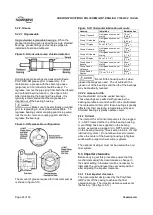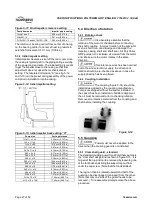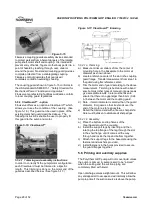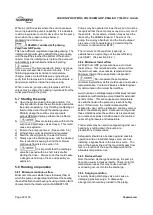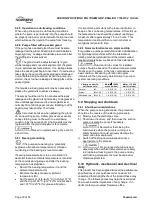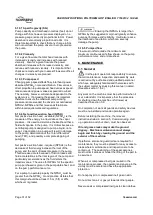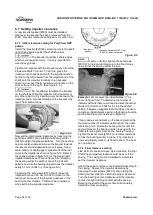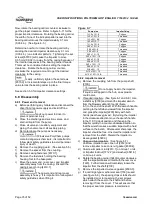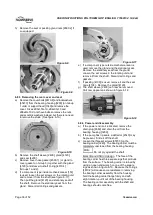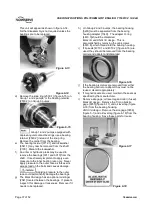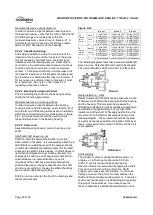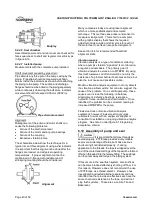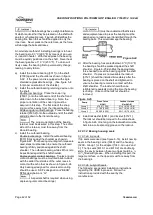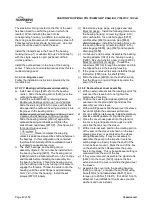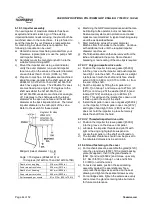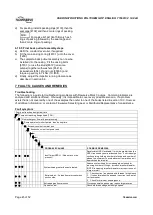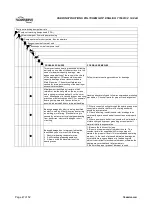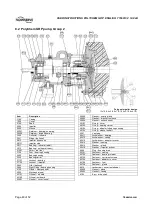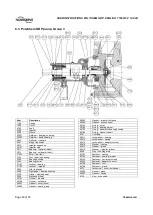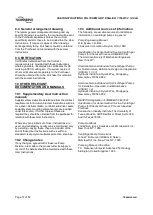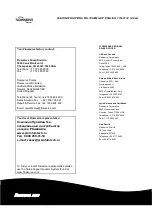
USER INSTRUCTIONS POLYCHEM GRP ENGLISH 71569132 12-04A
Page 40 of 52
flowserve.com
Endplay
6.9.4.6 Seal chamber
Assembled power end and rear cover are checked for
face squareness to shaft and register concentricity as
in figure 6-19.
6.9.4.7 Installed pump
Measurements with the complete pump installed.
Shaft movement caused by pipe strain
Pipe strain is any force put on the pump casing by the
piping. Pipe strain should be measured as shown
below. Install the indicators as shown before attaching
the piping to the pump. The suction and discharge
flanges should now be bolted to the piping separately
while continuously observing the indicators. Indicator
movement should not exceed 0.05 mm (0.002 in.).
Pipe strain movement
Alignment
Misalignment of the pump and motor shafts can
cause the following problems:
Failure of the mechanical seal
Failure of the motor and/or pump bearings
Failure of the coupling
Excessive vibration/noise
The schematics below show the technique for a
typical rim and face alignment using a dial indicator.
It is important that this alignment be done after the
flanges are loaded, and at typical operating
temperatures. If proper alignment cannot be
maintained a C-flange motor adapter and or
stilt/spring mounting should be considered.
Alignment
Many companies today are using laser alignment
which is a more sophisticated and accurate
technique. This method uses a laser and sensor to
measure misalignment. This is fed to a computer
with a graphic display that shows the required
adjustment side-to-side and shim stock for each of
the motor feet to achieve near-perfect alignment.
See section 4.8 for recommended final shaft
alignment limits.
Vibration analysis
Vibration analysis is a type of condition monitoring
where a pump’s vibration “signature” is monitored on
a regular, periodic basis. The primary goal of
vibration analysis is extension on MTBPM. By using
this tool Flowserve can often determine not only the
existence of a problem before it becomes serious, but
also the root cause and possible solution.
Modern vibration analysis equipment not only detects
if a vibration problem exists, but can also suggest the
cause of the problem. On a centrifugal pump, these
causes can include the following: unbalance,
misalignment, defective bearings, resonance,
hydraulic forces, cavitation and recirculation. Once
identified, the problem can be corrected, leading to
increased MTBPM for the pump.
Flowserve does not make vibration analysis
equipment, however Flowserve strongly urges
customers to work with an equipment supplier or
consultant to establish an on-going vibration analysis
program. See note 3 under figure 6-19 regarding
acceptance criteria.
6.10 Assembly of pump and seal
It is important that all pipe threads be
sealed properly. PTFE tape provides a very reliable
seal over a wide range of fluids, but it has a serious
shortcoming if not installed properly. If, during
application to the threads, the tape is wrapped over the
end of the male thread, strings of the tape will be formed
off when threaded into the female fitting. These strings
can then tear away and lodge in the piping system.
If this occurs in the seal flush system, small orifices
can become blocked effectively shutting off flow. For
this reason, Flowserve does not recommend the use
of PTFE tape as a thread sealant. Flowserve has
investigated and tested alternate sealants and has
identified two that provide an effective seal, have the
same chemical resistance as the tape, and will not
plug flush systems. These are La-co Slic-Tite and
Bakerseal.

